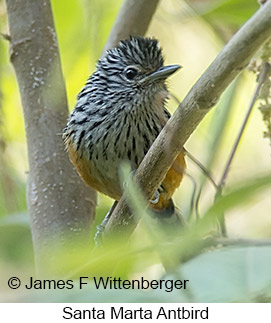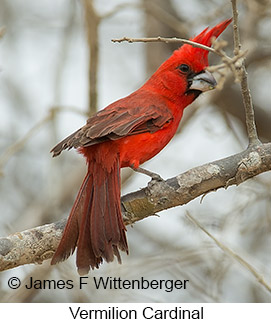COLOMBIA BIRDING TRIP REPORT

TRIP REPORT
COLOMBIA
| Start: | 04/15/2019 |
| End: | 04/24/2019 |
| Duration: | 10 days |
| #Species: | 302 |
| #Endemics: | 51 |
| #Heard Only: | 20 |
2019 Northern Colombia Birding Tour
TOUR DESCRIPTION
I met my guide for dinner the evening before the tour in Barranquilla, a largely commercial center not far from the coast of northern Colombia. We left the following morning, day 2 of the tour, at 5:40am. Our first birding stop was KM4 along the main highway, where birding along a dirt side road can be very productive. We arrived there at 6:15am after traversing Barranaquilla. The habitat there is a combination of open dry forest, fincas, and wetlands. Birds of special note seen well and sometimes photographed were Russet-throated Puffbird, Spot-breasted Woodpecker, Yellow-chinned Spinetail, Northern Scrub-Flycatcher, Stripe-backed Wren, and Yellow Oriole. Other widely distributed species we picked up included Bare-faced Ibis, Snail Kite, Red-crowned Woodpecker, Bicolored Wren, and many wetland species. From there we drove to Isla Salamanca National Park. This coastal area features both mangroves and coastal forest. The area was quite dry, as was all of northern Colombia during the tour, because the previous rainy season had been unusually dry and April is toward the end of dry season. We mainly birded along a boardwalk through the mangroves. Notable birds were Chestnut Piculet, Golden-olive Woodpecker, and Black-crested Antshrike. From there we continued on to Minca, a very touristy town in the foothills on the road into the Santa Marta Mountains, arriving there at 1:30pm for late lunch. At hummingbird feeders we picked up White-necked Jacobin, Pale-bellied Hermit, White-vented Plumeleteer, Steely-vented Hummingbird, and Rufous-vented Hummingbird. At 3:30pm we went birding along the road outside town. We picked up our main target bird an hour and a half later, a female Black-backed Antshrike. Meanwhile, we had good views of a second target species that is likely a future split, Northern White-fringed Antwren. Other birds seen included Whooping Motmot, Rufous-tailed Jacamar, Lineated Woodpecker, Cocoa Woodcreeper, Giant Cowbird, Crimson-backed Tanager, Swallow and Tanager.
The following morning, day 3, we left Minca at 6:00am after early breakfast, birding the road going up into the highlands. We had great views of Golden-winged Sparrow, a normally skulky bird that perched in the open for stunning views. We also had good views of Santa Marta Antbird, Rusty-breasted Antpitta, Black-chested Jay, Rufous-breasted Wren, Rufous-and-white Wren, and Bay-headed Tanager. Farther up the road we pulled out a Santa Marta Tapaculo for stunning views in the open without too much effort. Other birds seen well included Groove-billed Toucanet, Santa Marta Foliage-gleaner, Spectacled Tyrannulet, Golden-faced Tyrannulet, Gray-capped Flycatcher, Gray-breasted Wood-Wren (a likely split into Banks's Wood-Wren), White-necked Thrush, Santa Matta Brushfinch, Rufous-capped Warbler, White-lored Warbler, Black-headed Tanager, and Rusty Flowerpiercer. Higher up the mountain we stopped at a couple tiendas were flowers attracted hummingbirds, most notably Santa Marta Blossomcrown and a female Coppery Emerald. We arrived at El Dorado Lodge in time for lunch. We spent the afternoon watching birds come to the feeders around the lodge. The most common hummingbirds were Lesser Violetear, Brown Violetear, and Crowned Woodnymph. A few Sparkling Violetears were also at the feeders. Occasionally the endemic White-tailed Starfrontlet and Lazuline Sabrewing show up also. A female of the former and a male of the latter appeared that afternoon. We also saw Black-fronted Wood-Quail, Lined Quail-Dove, Southern Emerald-Toucanet, Black-chested Jay, Blue-naped Chlorophonia, Black-capped Tanager, and White-lined Flowerpiercer were seen around the lodge in the gardens or at the feeders. That night we went looking for owls. We saw a Kinkajou and heard Santa Marta Screech-Owls but couldn't manage to see them.
On day 4 we left at 4:40am for the highlands above the lodge. It's a very rough road and takes an hour to reach the ridgeline where our target birds are located. We quickly saw a soaring White-rumped Hawk and had the good fortune of hearing and then viewing 3 perched Santa Marta Parakeets. This species is often very difficult to locate and often missed so we counted ourselves very fortunate to have such good luck first thing in the morning. We quite quickly found two primary target birds, Santa Marta Warbler, Yellow-crowned Whitestart, and Black-cheeked Mountain-Tanager. It look longer and more effort but we eventually had superb views of Brown-rumped Tapaculo as well. We also had good views of a perched Black-and-chestnut Hawk-Eagle perched some distance away. Other notable finds were Streak-capped Spinetail and Rusty-headed Spinetail. Also seen in the highlands were Red-billed Parrot, Scarlet-fronted Parakeet, Montane Foliage-gleaner, Flammulated Treehunter, and Hermit Wood-Wren (a likely future split from Gray-breasted Wood-Wren). We returned to the lodge in time for lunch. That afternoon we spent some time hoping to see a male White-tailed Starfrontlet, which finally appeared at one of the feeders. We also birded a trail near the lodge and picked up a few widely distributed species such as Cinnamon Flycatcher and others. That night we went looking for Santa Marta Screech-Owl again and eventually had great views of one.
After 7:30am breakfast on day 5, we drove part way back up the highlands to the national park. On the way up we had excellent views of White-tipped Quetzal. Inside the park we had great views of Santa Marta Antpitta lured into the open by one of the park employees. We also had good views of Band-tailed Pigeon, Tyrian Metaltail, Mountain Velvetbreast, Great Thrush, Golden Grosbeak, and Black Flowerpiercer . Along the road we saw Black-throated Tody-Tyrant, Golden-crowned Flycatcher, and Golden-breasted Fruiteater. After lunch back at the lodge we drove the rough road back down to Minca. At the feeders near the hotel in Minca we saw Rusty Flowerpiercer.
On day 6 we left Minca for the lowlands at 5:50am. Our first stop was Bonda Road, where we spent several hours of excellent birding. Notable birds there included Coppery Emerald, Russet-throated Puffbird, Orange-chinned Parakeet, Black-backed Antshrike, Northern White-fringed Antwren, Greenish Elaenia, Pearly-vented Tody-Tyrant, Scrub Greenlet, and Trinidad Euphonia. We then continued on to Gaviotas Road. There we picked up Gray-headed Kite, Forest Elaenia, and Crimson-backed Tanager. We tried hard for our main target, Lance-tailed Manakin, which we heard but never saw. From there we drove to Los Flamencos National Park, where water levels were extraordinarily low. En route we had good views of Great Black-Hawk. At Los Flamencos we saw a variety of aquatic birds but not American Flamingos, which were in a quite remote part of the park due to the very low water levels.
We left at 5:10am on day 7 for a visit to a private site near Los Flamencos where Vermilion Cardinals come to feeders. We saw those and also Crested Bobwhite, Bare-eyed Pigeon, Rufous-breasted Hermit, Red-billed Emerald, Green-rumped Parrotlet, White-whiskered Spinetail, Slender-billed Tyrannulet, Pileated Finch, and Orinocan Saltator at the private site or in the park. In the nearby town square we picked up Glaucous Tanager. A local guide took us to a site where Tocuyo Sparrow had been seen recently but we had no luck with that bird. Along the road on our way back we saw a single Scarlet Ibis flying with a couple White Ibises. We also saw a Harris Hawk on the shoulder of the road. At 3:00pm we stopped at Los Besotes, a dry forest site en route to Perija. Notable birds seen there were Rufous-vented Chachalaca, Rufous-breasted Hermit, White-vented Plumeleteer, and Black-crested Antshrike. We arrived at our hotel in Perija at 5:10pm.
We left at 5:30am on day 8 for the long drive into the Perija Mountains. During the altitudinal transect en route to our lodge, we picked up Southern Emerald-Toucanet, Yellow-throated Toucan, Perija Tapaculo, Rufous Spinetail, Black-fronted Brushfinch, a likely future split from Yellow-breasted Brushfinch, Perija Brushfinch, Chestnut-capped Brushfinch, Golden-winged Sparrow, Black-headed Tanager, Swallow Tanager, and other species. We arrived at the lodge at 10:45. The lodge is very basic, is at quite high altitude where it is and was for us often foggy, and there is no heat in the rooms. Birding was limited the rest of the day due to the quite dense fog. At the feeders we did see Lesser Violetear, Sparkling Violetear, Amethyst-throated Sunangel (sometimes split as Longuemare's Sunangel), Mountain Velvetbreast, Great Thrush (paler than those of Ecuador), Slaty Brushfinch, and Black-crested Warbler.
On day 9 we left at 6:00am for the altiplano at higher elevation. It was foggy and overcast near the lodge but at high elevation around 3000m we enjoyed a sunny morning. Bird activity dies down and makes viewing of our target birds difficult by 7:30am. With our early arrival, we quickly picked up all three target species, namely Perija Metaltail (female only), Streak-backed Canastero, and Perija Thistletail. We also saw Streak-throated Bush-Tyrant and Rufous-breasted Chat-Tyrant. On our way back down we heard a Highland Tinamou quite close to the road but in deep understory. My guide finally had a brief view of it after trying with playback for some time, but I missed it. Back at the lodge we again experienced quite a bit of fog most of the day. During a brief period of clearing between rain squalls in the afternoon, birding along the road produced Strong-billed Woodcreeper, Streaked Xenops, Buff-breasted Mountain-Tanager, Paramo Seedeater, and other widely distributed species.
Day 10 was the last day of the tour. The day dawned clear and free of fog that morning, but we had to leave after breakfast for our afternoon flights out of Valledupar. During the transect down the mountain that morning we picked up a female Rufous-shafted Woodstar, Laughing Falcon, Piratic Flycatcher, Fork-tailed Flycatcher, 8 Red-crested Cotingas in a single tree, Brown-bellied Swallow, Chestnut-capped Brushfinch, and Beryl-spangled Tanager. The tour ended at the airport in Valledupar.
BIRDING LOCALES










